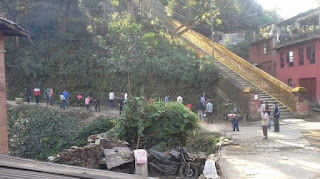Written by: Maartje Geverinck, volunteer from the Netherlands
Kay Garnay for Nepal, an NGO registered in Nepal, is the brain child of Amanda Summers, a retired expat living in the Kathmandu Valley. It is a humanitarian, nonprofit agency with the goal of supporting the artists, craftsmen and other residents of Changunarayan, an ancient village in Nepal, as well as those in neighboring communities.
Clean-up Campaign in Changunarayan
Kay Garnay for Nepal, an NGO registered in Nepal, is the brain child of Amanda Summers, a retired expat living in the Kathmandu Valley. It is a humanitarian, nonprofit agency with the goal of supporting the artists, craftsmen and other residents of Changunarayan, an ancient village in Nepal, as well as those in neighboring communities.
Clean-up Campaign in Changunarayan
People talk about how Nepali are litterbugs and don't care about the environment. There are actually some good reasons for this to appear to be true.
First, there are very few sanitary landfills in the entire country. Additionally even municipalities will use the river as dumpsites.
We, at Kay Garnay for Nepal, NGO, wanted to clean Changunarayan before the coming festival, Dashain. Our chairperson, Sajana, purchased gloves and other clean-up gear and about 50 people participated in the morning activities. This was our first of such community activities, so we learned a lot.
10 October 2015 - 7 o' clock in the morning
People in Changu gather to start picking up trash.
10 October 2015 - 7 o' clock in the morning
People in Changu gather to start picking up trash.
Gloves, mouth masks and some homemade litter spears were provided.
All in all about 50 people, young to old, were eager to start cleaning up their village. There was only one tourist among the volunteers.
All in all about 50 people, young to old, were eager to start cleaning up their village. There was only one tourist among the volunteers.
Rather than using plastic bags, we used bamboo baskets and wheelbarrows to collect the debris.
Bio-degradable organic materials were supposed to be put in one pit and another one dug for the plastics.
However, that didn’t happen as planned.
Afterwards, according to our plan, a truck would come from Kathmandu to collect everything and take it to the recycling center - not to the river or burned.
The locals weren't informed properly to make this first clean-up campaign successful. There was just no awareness that if, for example, you sprinkle insecticide along the road most of the insects will just move to a nearby garden or farm.
 Yes, posters were made beforehand and distributed to places frequently visited by locals, but there was a lack of knowledge on how to start cleaning and how to get rid of the trash. We need to keep in mind as Westerners that it was we who introduced such poisons into this environment only 60 years ago.
Yes, posters were made beforehand and distributed to places frequently visited by locals, but there was a lack of knowledge on how to start cleaning and how to get rid of the trash. We need to keep in mind as Westerners that it was we who introduced such poisons into this environment only 60 years ago.While seeing how everyone was working and doing all the best they could, I saw boys cutting greenery from the walls with bamboo sticks and girls using the Nepali brooms to push the cut greenery from one side of the road down the hill. Not all plastics were removed first and the greens and sand were just put on top. So I was witnessing a worst case scenario. But yeah: “Kay Garnay” (meaning: “What to do?”)
The problem is that you cannot blame the Nepali people. They do not get the required education to obtain the right knowledge on how to keep the Earth clean and safe to live on.
In my head, several new ways of how to tackle this situation have arisen meanwhile. We could find some handy pocket-size reusable bags and distribute these among the locals so that they can do their grocery shopping etc. by using these bags.
Also, we could make a presentation showing kids in school, ages 14-15, the 'Circle of Life' – and meanwhile hoping they will spread the message and be a living example of it.
Furthermore, a great effort must be done to reach the outside world by spreading messages about the actual situation and hopefully we will attract more eco-minded people to volunteer and help not only this city, but the entire Nepal with their ideas.
Tags
Changunarayan
environmental issues in Nepal
Nepal infrastructure
Village clean-up
Visit nepal
visit nepal 2020


